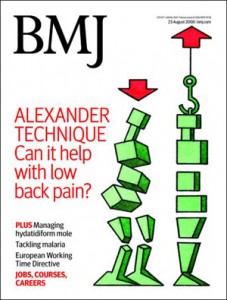 by Witold Fitz-Simon
In 2008, the British Medical Journal published the results of their randomized controlled trial of Alexander Technique lessons, exercise, and massage for chronic and recurrent back pain. This is not exactly news for those in the Alexander Technique community, as word of favorable scientific studies travel fast. The results were so positive in favor of the Technique, however, that it is worth giving them another look.
by Witold Fitz-Simon
In 2008, the British Medical Journal published the results of their randomized controlled trial of Alexander Technique lessons, exercise, and massage for chronic and recurrent back pain. This is not exactly news for those in the Alexander Technique community, as word of favorable scientific studies travel fast. The results were so positive in favor of the Technique, however, that it is worth giving them another look.
579 patients with chronic or recurring back pain were selected from 64 general practices in the United Kingdom. 144 people were given normal care for back pain that you might receive from any general practitioner. 147 were given six sessions of massage. 144 were given six Alexander Technique lessons. 144 were given 24 Alexander technique lessons. Half of the people in each of these groups were also given an exercise program.
The participants in the study were interviewed three months after their interventions were given, and again after twelve months. As you might expect, the control group showed no improvement after three months or beyond. Of the other groups, all showed some improvement. What is remarkable is what was found at the one-year mark. Those who had received massage reported they still experienced around 21 days of pain in the previous four weeks, whereas those who had taken six lessons in the Alexander Technique reported around 11 days of pain. Those who had taken 24 lessons in the Technique that ended a year previously reported only around 3 days of pain in the prior 4 weeks!
Here is the video that the BMJ produced explaining their study:
http://youtu.be/3GbwzqT9piU
http://youtu.be/BXmimtk381U
The American Center for the Alexander technique has a 50-year tradition of excellence in training teachers of the Alexander Technique. Click here to find a teacher near you.
[author] [author_image timthumb='on']http://www.acatnyc.org/main/wp-content/uploads/2014/01/After-crop1.jpg[/author_image] [author_info]WITOLD FITZ-SIMON has been a student of the Alexander Technique since 2007. He is certified to teach the Technique as a graduate of the American Center for the Alexander Technique’s 1,600-hour, three year training program. A student of yoga since 1993 and a teacher of yoga since 2000, Witold combines his extensive knowledge of the body and its use into intelligent and practical instruction designed to help his students free themselves of ineffective and damaging habits of body, mind and being. www.mindbodyandbeing.com[/author_info] [/author]


